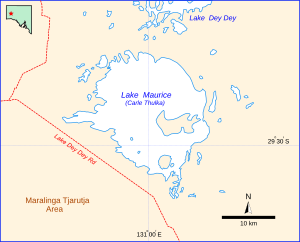Lake Maurice facts for kids
Quick facts for kids Lake Maurice |
|
|---|---|
 |
|
| Location | South Australia |
| Coordinates | 29°25′S 130°59′E / 29.417°S 130.983°E |
| Type | salt lake |
| Basin countries | Australia |
| Surface area | 29 km² |
Lake Maurice, also known as Carle Thulka, is a salt lake found in South Australia. It's the biggest of many salt lakes at the eastern end of the Great Victoria Desert. A salt lake is usually dry, but it fills up with water during and after heavy rain. When it's full, the lake covers about 29 square kilometers.
Lake Maurice is part of a large geological basin called the Officer Basin. A smaller lake, Lake Dey Dey, is located to its north. Since 1985, Lake Maurice has been part of the land belonging to the Maralinga Tjarutja people. They are a southern group of the Pitjantjatjara people. The community of Oak Valley is close to the western side of the lake.
The ground of the lake is usually dry. It's made of clay, silt, or sand, with a salty crust on top. The area around Lake Maurice is very dry. People have drilled two wells nearby to look for uranium and other minerals. These wells have very little groundwater. The water they find has a lot of salt. It also contains radium and old sediments from the Cambrian era.
Exploring Lake Maurice's Past
This lake is named after an explorer named Richard D. Maurice. He went on at least eight trips into the Great Victoria Desert between 1897 and 1903. However, he wasn't the first European to visit this area. Ernest Giles and his team explored here almost 20 years earlier. Giles saw the lake in 1875 but didn't give it a name. He said the area was empty and that his team found no animals to hunt between Lake Maurice and the Western Australian border.
Richard Maurice, during his trips, wrote down information and collected samples of plants, animals, and the geology of the area. In 1904, a mining surveyor named Frank George led a trip to search for minerals. He used Maurice's camels and equipment. George traveled northwest of Lake Dey Dey and into Western Australia. He was the one who named Lake Maurice. He reported that the area probably didn't have anything useful for mining.
Nuclear Tests and Their Impact
The area around Lake Maurice was affected by nuclear weapon tests in the 1950s. Many Aboriginal families were asked to move from their traditional lands. They went to towns far away, like Ernabella, Yalata, Ooldea, Cundeelee, and Warburton.
In the late 1940s, an officer named Walter MacDougall was sent to tell people in the area about the upcoming tests. The tests could have been dangerous for anyone nearby. Officially, everyone was asked to leave their lands and stay at least 200 kilometers away from where the tests would happen. However, only one officer and an assistant were in charge of warning people across a very large area. This meant many people were not told, and some did not leave. Planes dropped information leaflets, but the local people could not read them. They were also careful or afraid of the planes.

